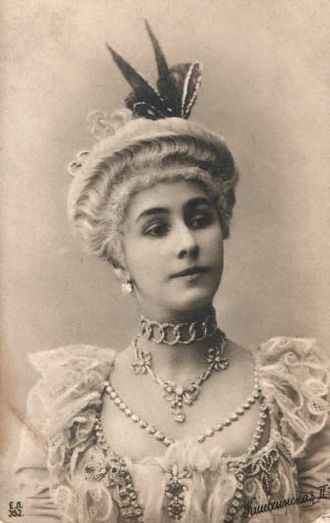Prominent Poles
Matylda Krzesińska aka Mathilda-Marie Feliksovna Kschessinskaya aka Mathilde Kschessinska (also known from 1935 as Her Serene Highness Princess Romanova-Krasinskaya) , Russian ballerina of Polish decent. Her father Feliks Krzesiński and her brother both danced in St. Petersburg. She eventually attained the highest rank, that of prima ballerina assoluta. She was also a mistress of the future Tsar Nicholas II of Russia.

Born: 31 August 1872 in Ligovo, Petergof, Russia
Died: 6 December 1971 in Paris, France
Early days. Like all her Polish family, Matylda performed at the Imperial Mariinsky Theatre of St Petersburg with the renowned Imperial Ballet. Krzesińska made her début in a pas de deux from La Fille Mal Gardée during a graduation performance in 1890 attended by Emperor Alexander III and the rest of the Imperial family, including the future Nicholas II. At the post-performance supper, Tsar Alexander sought out the young Krzesińska and told her to "Be the glory and adornment of our ballet."
Prima ballerina. In 1896, she obtained the rank of Prima ballerina of the St. Petersburg Imperial Theatres. The old maestro Petipa did not consent to its granting to Krzesińska and she obtained it primarily via her prestige at the Imperial Russian Court.
Relationship with Petipa. Petipa allowed Krzesińska to create only a small number of new roles, as he considered Legnani to be the superior ballerina. Although she was able to command top billing in theatre programs or on posters, her efforts to obtain more new roles were thwarted by Petipa, whose authority over the artistic direction of the Imperial Ballet was not even challenged by the Emperor himself. Among the few roles Krzesińska created were Flora in Le Réveil de Flore (1894) and Columbine in Harlequinade (1900). She also became the first Russian danseuse to master the 32 fouettés of Legnani. Although Petipa had a great respect for Kschessinskaya as a dancer, he apparently despised her as a person, referring to her in his diaries as " ... that nasty little swine." Even so, he chose her for the lead roles in many of the final revivals of his older masterworks, often devising intricate choreography for her to execute. In 1899, Prince Serge Wolkonsky became Director of the Imperial Theaters. Although he held the position only until 1902, he achieved a great deal. However, Wolkonsky was forced to send in his resignation after refusing Krzesińska 's request for a revival of the romantic ballet Catarina.
Relationships. Krzesińska had been involved with the future Nicholas II, from 1890, when he was a grand duke and she was just seventeen, having met him in the presence of his family after her graduation performance. The relationship continued for three years, until Nicholas married Princess Alix of Hesse-Darmstadt—the future Empress Alexandra Fyodorovna—in 1894. Scandals and rumors around her name developed and persisted as she engaged in a sexual relationship with two Grand Dukes of the Romanov family: Sergei Mikhailovich and his cousin Andrei Vladimirovich. In 1902, she gave birth to a son, Vladimir (known as "Vova”).
Ruthless with rivals. While Kschessinska could be charming and kind to colleagues, she was not afraid to use her connections with the Tsar to strengthen her position in the Imperial Theaters. She could also be ruthless with rivals. One of her most famous miscalculations occurred when, while pregnant in 1902, she coached Anna Pavlova in the role of Nikya in La Bayadère. She considered Pavlova to be technically weak and believed that the other ballerina could not upstage her. Instead, audiences became enthralled with the frail, long-limbed, ethereal-looking Pavlova. Another notorious incident occurred in 1906 when Krzesińska 's coveted role of Lise in the Petipa/Ivanov production of La Fille Mal Gardée was given to Olga Preobrajenska. One feature of this production was the use of live chickens on stage. Before Preobrajenska's variation in the Pas de ruban of the first act, Krzesińska opened the doors to the chickens' coops and, at the first note of the music, the chickens went flying about the stage. Nevertheless, Preobrajenska continued her variation to the end and received a storm of applause, much to Krzesińska 's chagrin.
Finances. Through her aristocratic connections, she managed to amass much valuable property in the Russian capital. It was from the balcony of her elegant house that Vladimir Lenin addressed the revolutionary crowd when he returned from Finland in 1917.
Move to France. After the Russian Revolution, Krzesińska moved first to the French Riviera and then to Paris, where she married, in 1921, one of the tsar's cousins, Grand Duke Andrei Vladimirovich of Russia, the possible father of her son Vova. Although Krzesińska 's life in Paris was modest compared with the lavish life she had enjoyed in Russia, she lived on happily for over fifty years. In 1925 Mathilde converted from Catholicism to Russian Orthodoxy and took the name Maria. In 1929, she opened her own ballet school, where she taught such students as Dame Margot Fonteyn, Dame Alicia Markova, André Eglevsky, Tatiana Riabouchinska and Tamara Toumanova. She performed for the last time at the age of 64, for a charity event with The Royal Ballet at Covent Garden. In 1960, she published an autobiography published in English as Dancing in St. Petersburg: The Memoirs of Kschessinska. In later years, she suffered financial difficulties but remained indomitable. She died in Paris, eight months short of her 100th birthday.
This article uses mostly material from the Wikipedia article "Mathilde Kshessinskaya." :
Wikipedia
The text is available under the Creative Commons Attribution-ShareAlike License; additional terms may apply.
Return to home page:
Prominent Poles
